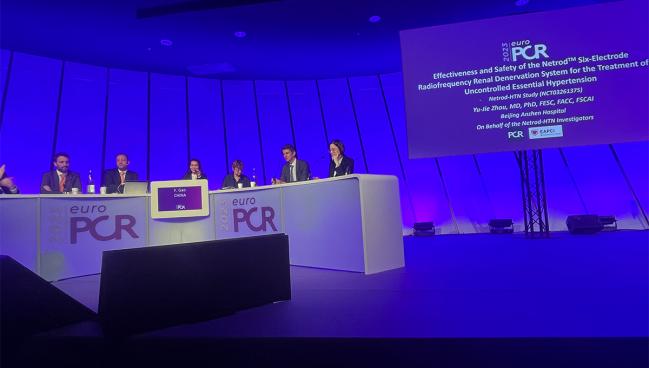Two New Renal Denervation Systems Look Good in Uncontrolled BP
The studies are “reassuring that renal denervation works and that renal denervation is safe,” one expert says.

PARIS, France—Two new renal denervation (RDN) systems seem to be safe and effective in patients with uncontrolled hypertension, according to presentations here at EuroPCR 2023.
In the SMART trial, a system that involves mapping the renal arteries and then selectively ablating “hot spots” provided a high rate of blood pressure control that was noninferior to what was achieved in the sham-control arm, but with a lower burden of antihypertensive medication.
And in a separate trial, denervation with a system that includes a six-electrode catheter with a basket-shaped design resulted in a much greater reduction in office systolic BP, and other BP measures, at 6 months than did a sham procedure.
There were few safety events in the trials, both of which were conducted in China.
Commenting for TCTMD, Lucas Lauder, MD (Saarland University Medical Center, Homburg/Saar, Germany), said that taken together, the studies add to data from previous sham-controlled trials—which, following the failure of SYMPLICITY HTN-3, have been mostly positive—and are “reassuring that renal denervation works and that renal denervation is safe.”
The SMART Study
In introducing the SMART study, Jie Wang, MD, PhD (Jiangsu Province Hospital, Nanjing, China), noted that no prior pivotal trials of renal denervation have examined the impact on medication burden as part of the primary endpoint. Although patients want to know how much their BP will fall with the procedure, they also want to know whether they can get rid of all or some of their medications, Wang said during a press conference. “I think we need to answer both questions.”
The SMART study, conducted at 15 centers in China, was designed to do that. It included 219 patients (mean age roughly 45 years; 87% men) who had essential hypertension and uncontrolled BP despite use of at least two antihypertensive medications. All patients underwent renal angiography and were then randomized to either renal denervation or sham control.
Denervation was performed using the SyMapCath I catheter and the SYMPIONEER S1 stimulator/generator (SyMap Medical Ltd). Using the system, operators applied electronic stimulation within the renal arteries to look for spots associated with an increase in systolic BP greater than 5 mm Hg. These “hot spots” were then ablated, with other areas left alone. Additional stimulation was applied after ablation to ensure that denervation was achieved. “Therefore, we are able to map/ablate sympathetic nerves and also validate the effect of RDN,” Wang said.
On average, about four hot spots were ablated in both the left and right renal arteries.
The combined primary outcomes were the rate of office systolic BP control to less than 140 mm Hg, assessed for noninferiority versus sham, and the change in the drug index, which takes into account both the number of classes of antihypertensive drugs and the doses, at 6 months.
Baseline office BP was roughly 159 mm Hg in both groups, falling by an average of 25.2 mm Hg in the denervation arm and 27.3 mm Hg in the control arm. The vast majority of patients in each arm achieved control (95.4% and 92.7%, respectively). The between-group difference was 2.69% (95% CI -4.11% to 9.83%), meeting criteria for noninferiority with a margin of 10%.
The drug index rose in both groups, indicating a need for more medications or higher doses to achieve BP control, although the increase was significantly smaller in the denervation arm (4.37 vs 7.61; P = 0.003).
Drug adherence assessed by urine testing was similarly high in both trial arms (about 90% at 6 months).
In terms of safety, there were no deaths and no cases of severe renal dysfunction in either group. One patient developed renal artery stenosis in the denervation arm. The rate of serious adverse events was 10.8% in the denervation arm and 9.2% in the control arm (P = 0.823).
“We demonstrated the safety and the efficacy of renal mapping/selective denervation in patients with uncontrolled hypertension,” Wang said. “Also, the therapy achieved the goals to reduce drug burden of hypertension patients with four targeted ablations per renal artery and to control blood pressure [to] less than 140 mm Hg.”
Lauder said it was surprising to see no difference in BP control between the two arms, but noted that overall control in the trial was very high.
Asked about how to interpret that finding in the context of a decreased medication burden in the denervation group, he said, “The most important goal is always blood pressure control because we want to reduce cardiovascular outcomes, but we know high pill burden is an obstacle for adherence. So I do think it’s important for the patient to reduce the pill burden, but I think it’s our first goal to reduce blood pressure.”
The Netrod System
Fei Gao, MD (Beijing Anzhen Hospital, China), who presented results from a trial of the Netrod renal denervation system, noted that “currently, evidence suggests that RDN technology could provide a potential therapeutic option for patients with uncontrolled hypertension,” but added that “there’s still room for improvement.”
The Netrod system (Shanghai Golden Leaf MedTec Co. Ltd.), Gao said, consists of a radiofrequency catheter with a basket-like tip with six electrodes in a spiral array that provides better wall contact and simultaneous ablation in all parts of the renal artery, ensuring circumferential ablation. The catheter is adjustable for various vessel sizes ranging from 3 to 12 mm.
Gao presented the results of a trial conducted at 25 centers. It included 205 patients (mean age about 50 years; 16% women) who had uncontrolled essential hypertension despite taking at least two antihypertensive drugs. They were randomized 2:1 to denervation with the Netrod system or sham control (renal angiography). All patients were treated with a standardized two-drug regimen of nifedipine and hydrochlorothiazide.
At baseline, average office BP was roughly 161/100 mm Hg, with an average 24-hour BP of 152/96 mm Hg.
For the primary endpoint, denervation provided a significantly greater reduction in office systolic BP at 6 months than did the sham procedure (mean 25.2 vs 6.2 mm Hg; P < 0.001). There were also significantly greater reductions office diastolic BP and 24-hour systolic and diastolic BP.
Patients treated with denervation were more likely to achieve the target office systolic BP of 90 to 140 mm Hg (64.7% vs 7.7%) and at least a 5-mm Hg reduction in office systolic BP (93.4% vs 60.0%; P < 0.0001 for both).
Rates of device- or procedure-related serious adverse events were low overall, with no cases of renal artery stenosis. One patient in the denervation arm had a renal artery dissection but that was related to angiography and not the device, Gao said.
The “novel Netrod RDN system is safe and effective in treating patients with uncontrolled hypertension,” she concluded.
The reduction in BP achieved in this trial is conspicuously lower than that seen in other recent studies, William Wijns, MD (Lambe Institute for Translational Medicine and CÚRAM, Galway, Ireland), pointed out in a Tuesday morning press conference. That may stem from three factors, Gao replied. First, the patients were relatively young and free from cardiovascular risk factors, and prior studies have indicated a greater benefit of renal denervation in this population. Second, there was a standardized two-drug regimen used in all patients, and only 19 patients had an adjustment during the course of the trial, minimizing potential bias related to drug use. Third, the unique six-electrode design of the device, ensuring complete circumferential ablation, could explain the degree of BP-lowering.
Lauder indicated that it’s unclear what’s behind the large BP drop seen in this study, adding that it’s hard to know if it’s related to device design or something else without head-to-head comparisons with other denervation systems.
“It seems to work, but we can’t compare the blood pressure differences between the trials,” he said.
Todd Neale is the Associate News Editor for TCTMD and a Senior Medical Journalist. He got his start in journalism at …
Read Full BioSources
Wang J. Pivotal trial of target renal denervation to treat hypertension: SMART study. Presented at: EuroPCR 2023. May 17, 2023. Paris, France.
Gao F. Effectiveness and safety of the Netrod six-electrode radiofrequency renal denervation system for the treatment of uncontrolled essential hypertension: a prospective multicenter randomized sham-controlled clinical trial. Presented at: EuroPCR 2023. May 17, 2023. Paris, France.
Disclosures
- SMART was sponsored by SyMap Medical Ltd.
- Wang reports receiving honoraria/consulting fees and travel grants, as well as being a co-founder of, SyMap Medical Ltd.
- Gao reports no relevant conflicts of interest.





Comments